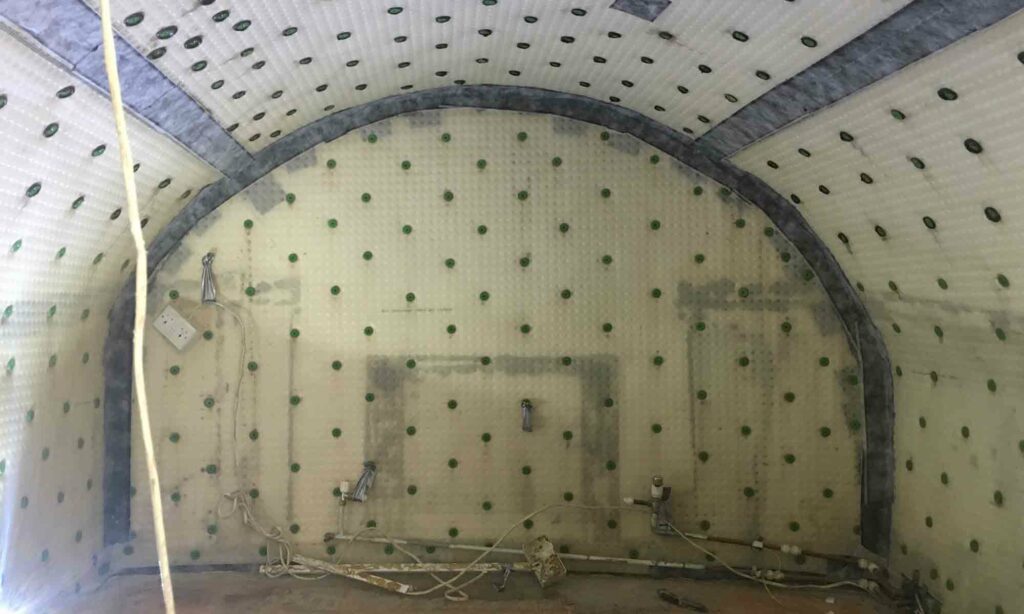Tanking a Cellar

Most people that have cellars tend to completely overlook the development opportunity for them. They usually see them as a damp area, with no practical use, but cellars have a lot more potential than people realise.
These areas can be transformed from a damp wasted space into a practical storage area or additional living space freeing up much valued space in your home. By fitting a waterproofing system, the area can be totally transformed.
There are two systems of waterproofing a cellar; you can install a cavity drainage system, or you can use a tanking system depending on the size and of the cellar.
Tired of reading? Listen to this article!
What Is Cellar Tanking?
Tanking refers to the application of a waterproof cement or cementitious slurry to the walls, floors and sometimes ceiling of a cellar. It is used to treat damp walls by preventing water ingress, effectively making the walls permanently watertight.
Damp walls are common in cellars because the walls are generally below ground, meaning that water from the surrounding earth can penetrate through the wall structure, carrying salts and minerals with it.
Tanking slurry is designed to deal with these issues and can be applied directly to properly prepared damp walls. When the tanking slurry cures, it forms a waterproof barrier, preventing water ingress and damp.
What Is Tanking Slurry?
The most effective way of tanking your basement or cellar is with tanking slurry. You may see this referred to as cementitious tanking. The waterproofing product is a specially formulated mixture designed to be applied to cellar walls, floors and ceilings to stop water ingress.
The Difference Between Cellar Tanking and Waterproofing
We often get asked what the difference is between ‘tanking’ and ‘waterproofing’ when people are looking to convert a basement or cellar into a dry space. Cellar waterproofing typically refers to all types of cellar systems (barrier, integral and drained waterproofing). Whereas cellar tanking describes the application of one type of coating applied directly to the surface (barrier protection).
Choosing the Most Effective Waterproofing Solution
Where possible we would always recommend that a drainage system is included as part of any waterproofing approach for existing structures. This system manages any water entering the Cellar or Basement rather than relying on just a tanking coating holding back the water.There are essentially 3 options for basement waterproofing to existing below ground areas:
- Option 1 – a Cavity Drain System, comprising of waterproof membranes, drainage, pumping and control systems to manage water entering the property and safely remove it
- Option 2 – using tanking slurry applied to the surfaces of the basement or cellar to hold back the ground water from entering the area.
- Option 3 – a combination of the two where flat soffits may restrict the flow of water above the membrane.
Cavity drainage systems can be hidden from view behind finished walls and underneath finished floors, making them an ideal solution for larger cellars. Our fully qualified surveyors can advise on the best solution for your below ground area.
Cellar Tanking Survey
No matter what damp problem you have in your property our experienced and qualified damp surveyors understand the importance in accurately identifying the cause of the damp problem. Once the damp issue is diagnosed a cost-effective solution will then be tailored to your below ground area to solve the damp problem.
Misdiagnosis and the wrong treatment will not solve the problem and will cost more to fix. An approved damp surveyor will be qualified to CSSW (Certificated Surveyor for Structural Waterproofing) and this qualification should be checked with the surveyor. Should you require a property survey or advice please contact your local Richardson & Starling branch and our team will be pleased to help you.Would you like to damp proof your cellar? Get it your property surveyed by a specialist surveyor.
